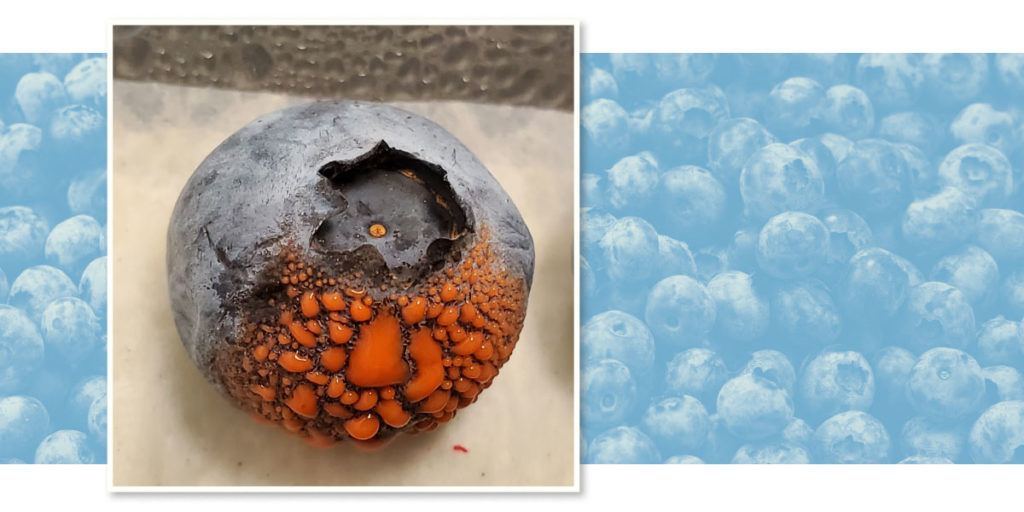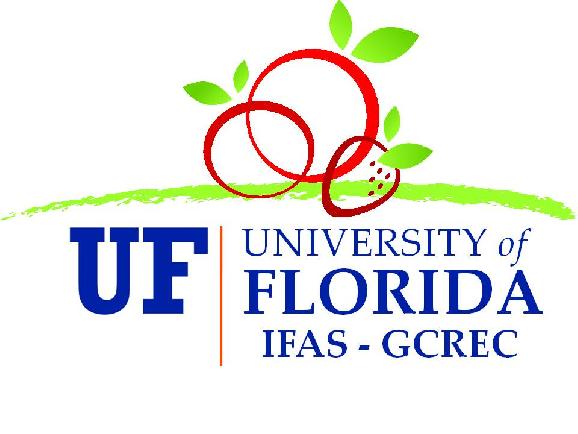By Philip Harmon and Doug Phillips
Anthracnose fruit rot (AFR), also known as ripe rot, is a significant disease on southern highbush blueberries. Caused by the fungal pathogen Colletotrichum gloeosporioides on southern highbush blueberries in Florida, AFR creates sunken lesions on the surface of blueberries. This is followed by eruptions of orange- or salmon-colored spores from the lesions when the fruit starts to ripen and as the disease progresses (Figure 1). AFR can lower fruit packouts, shorten the shelf life of fruit that is marketed, and spread to other harvested fruit through sorting and packing lines.

Photo by A. Gama, University of Florida
The pathogen can overwinter in infected bud scales and stems, or in foliage in evergreen production systems. The disease spreads to healthy tissues through water splash from rainfall or overhead irrigation. C. gloeosporioides grows most effectively in warm temperatures (between 68 and 77 degrees) along with leaf wetness duration of eight hours or more.
Infection can occur over a long period, from bloom through postharvest. Infection of flowers and green fruit typically remain latent (show no symptoms) until fruit starts to ripen and the pathogen begins to break down the inside of the fruit and cause rot. Each cycle of warm and wet conditions from bloom through harvest represents another opportunity for the pathogen to infect fruit.
MANAGEMENT METHODS
Management of AFR can be accomplished through modification of horticultural inputs and by the application of fungicides. Cultural controls aim to reduce the amount of pathogen available to infect the fruit and to modify the environment to make conditions less favorable for infections to succeed (i.e., reduce moisture). Here are some management tips:
- Minimize the use of overhead irrigation to reduce canopy moisture needed for the fungus to produce spores that can infect healthy plant parts.
- Perform periodic post-harvest pruning of the plant canopy to provide for good airflow (minimizing the length of leaf wetness) and remove diseased wood that harbors the pathogen.
- Manage late-season anthracnose leaf spot disease (especially in evergreen systems).
- Harvest fruit soon after it is fully ripe (to prevent sporulation that can spread to adjacent fruit) and quickly move it into cold storage.
- Sanitize lugs, buckets and other harvesting equipment as well as sorting and packing equipment.
Timely fungicide application is an important part of effective AFR control. Historically, effective fungicides include certain products in the strobilurin (including azoxystrobin and pyraclostrobin) and demethylation inhibitor classes, along with captan. However, resistance has been observed in Florida to stobilurins and boscalid, so products containing those fungicides (including Abound and Pristine) should be tank-mixed with captan if used, following all label instructions. An effective rotation partner for these options from bloom through harvest is Switch. Specific product suggestions can be found in the University of Florida 2022 Florida Blueberry Integrated Pest Management Guide (edis.ifas.ufl.edu/publication/HS380).

GROWER RESOURCE
Many growers use a calendar-based spray schedule, typically at 7- to 10-day intervals, beginning during bloom and continuing throughout harvest. The University of Florida Institute of Food and Agricultural Sciences (UF/IFAS) has developed the Blueberry Advisory System (BAS) as a resource for growers to quantify how favorable the environment has been for AFR infections during the past few days. This knowledge can help growers prioritize and time fungicide applications for AFR management.
Users of the BAS (available at cloud.agroclimate.org/tools/bas/dashboard/disease) will receive a text or email notification when there is a moderate or high level of risk for the development of AFR, based on an algorithm that considers temperature and leaf wetness duration. There are also graphics and charts online that show risk data for different areas of Florida (Figures 2 and 3). The color of each circle with an A on the map of Florida (Figure 2) is related to the current risk based on the previous 24 hours of weather data. Green indicates low risk, yellow is moderate risk, and red is high risk. Growers can take this information into account when making decisions about when and which fungicide products to choose to apply to protect their crop.
During seasons that are generally dry and mild, growers may be able to reduce the number of fungicide applications while maintaining a similar level of disease control, resulting in cost savings. In addition, growers may choose to apply less expensive fungicides (e.g., captan) when there is only a moderate level of risk, while saving more expensive (and possibly more effective) products (e.g., Switch or Abound tank-mixed with captan) for when there is a high level of risk.
In UF/IFAS field trials performed on Florida commercial blueberry farms, improved yield and reduced disease levels were observed when the BAS and a UF/IFAS-suggested fungicide management program were used. Whether use of the BAS will reduce the number of fungicide applications depends on the user’s aversion to risk, current management strategies and weather favorability for AFR development.

CONCLUSION
In summary, AFR is a disease of growing importance. Increasing use of evergreen production and machine harvesting, trends toward warmer and wetter weather conditions during bloom through harvest, and the loss of efficacy of certain fungicides due to fungicide resistance make the disease an ongoing issue for the industry. By implementing suggested cultural and chemical controls during bloom and fruit development, growers can help reduce the risk of AFR infection and development.
Philip Harmon is a professor at the University of Florida in Gainesville. Doug Phillips is a UF/IFAS blueberry Extension coordinator at the Gulf Coast Research and Education Center in Wimauma.










